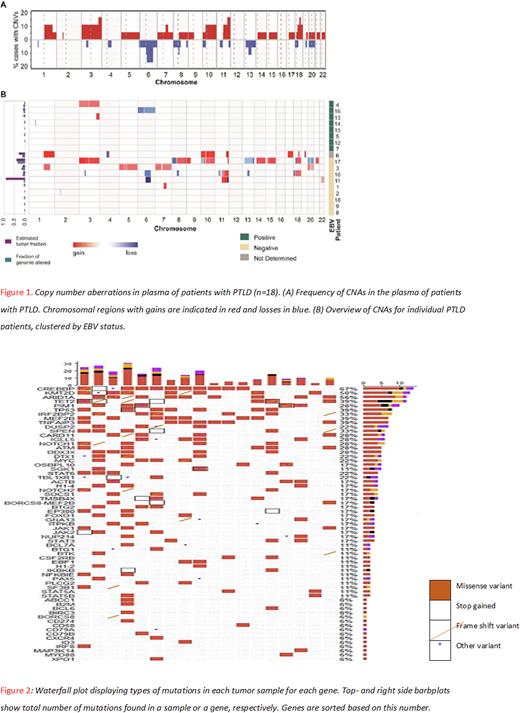Abstract
Introduction: Identification of post-transplant lymphoproliferative disorder (PTLD) is a diagnostic challenge. The current diagnostic framework usually require analysis on tissue and imaging through PET/CT scans. Yet, these methods have diagnostic limitations. For instance due to missing information on tumor heterogeneity and relatively low sensitivity of PET/CT scans. Measuring cell free DNA (cfDNA) represents a novel, minimally-invasive method for tumor detection and genotyping. In this study we explored the feasibility of plasma cfDNA tumor genotyping with targeted deep sequencing to detect copy number variation (CNV), single nucleotide variants (SNVs) and Epstein Bar Virus (EBV) sequences, using a new in-house variant calling pipeline.
Methods: In this multi-center observational cohort study of 18 patients diagnosed with monomorphic PTLD, we performed deep targeted NGS for SNV detection and low-coverage whole genome sequencing (lcWGS) for CNV detection. NGS was targeted on a panel of genes (n = 39) known to be recurrently mutated in B-cell lymphomas (244 kbp). All patients gave written informed consent. The R package CNAclinic was used to identify genome wide CNAs and fraction of the genome altered (FGA). The ichorCNA package was used to determine the ctDNA fraction in cfDNA samples. SNVs were called using a pipeline, combining 4 (cfDNA) SNV calling tools: Mutect2, LoFreq, VarDict & SiNVICT. Variants were filtered on presumed functional effect (Synonymous-, UTR-, Intron-, 2 kb upstream-, 2 kb downstream variants were removed). A "panel of normals” (variant blacklist) was generated from variants found in cfDNA from healthy controls, which was used to produce a variant blacklist to filter out technical artifacts and SNPs. Finally, variants with a variant allele frequency (VAF) < 1% and variants with an allele frequency (AF) of > 1% in 1000Genomes and/or gnomAD were filtered out.
Results: The cohort included 18 PTLD patients. The majority of patients had stage IV disease (n=13, 76%). All of the PTLD cases were histologically proven, of diffuse large B cell lymphoma type and 10/18 patients (55%) were considered to have an EBV-negative tumor. EBV copy number in plasma was performed by qPCR in 12 patients and was considered to be elevated in four patients (>5000 copies/mL).
The fraction of reads mapping to the EBV genome was compared between controls (n=8), EBV-negative PTLD (n=10) and EBV-positive PTLD (n=8). The median fraction of EBV reads for controls and EBV-negative PTLD were similar with a fraction of 1.5x10-4 (Q1-Q3: 1.3x10-4-1.6x10-4) and 1.8x10-4 (Q1-Q3: 1.4x10-4-3.9x10-4), respectively (p>0.05, Kruskal-Wallis). In EBV-positive tumors, the median fraction of EBV reads was 3-log higher, 5.3x10-1 (Q1-Q3: 7.3 x10-2-2) (p≤0.05, Kruskal-Wallis)
CNVs were detected in cfDNA of 11/18 (61%) patients. Two of the patients in whom no CNVs were detected had initiated therapy at the time of plasma sampling. Median fraction of genome altered was higher in EBV-negative tumors (0.03, Q1-Q3: 2.5x10-4-0.12) than in EBV-positive tumors (5x10-4, Q1-Q3: 0-0.03), but this difference was not significant (p>0.05, Mann-Whitney U) (Figure 1).
In the top 15 recurrently mutated genes (described below), across all 18 samples, 180 SNVs were found in total. The median amount of SNVs found in each sample was 11 (range 6-25). The most frequently mutated gene was CREPPB (12/18, 67%), in which the most prevalent mutation was p.K1497T (8/18, 44%). ARID1A was mutated in 10/18 cases (56%), followed by KMT2D (9/18, 50%). TET2, TP53, MEF2B & TNFAIP3 were all mutated in 7/18 cases (39%). SPEN & IRF2BP2 were mutated in 6/18 cases (33%). PIM1, NOTCH1, ATM, CARD11, DDX3X, IGLL5 were all mutated in 5/18 cases (28%) (Figure 2). Few of the mutations that are called in the top 15 recurrently mutated genes (8/180, 0.04%) lay close to 50% VAF, which might imply that these are SNPs not filtered out by the pipeline. Our SNV findings are comparable with previous literature, in which KMT2D, TET2 & TP53 are also amongst top-mutated genes (Menter et al., 2017), highlighting disruption of epigenetic regulation, NFkB pathway, and DNA damage response as drivers of PTLD.
Conclusion: lcWGS in combination deep targeted sequencing allows for detection of CNV an SNV in diagnostic samples of patients with monomorphic PTLD. These data can potentially be used at screening, diagnosis and response monitoring, which is part of the ongoing prospective study NTR 7402.
Disclosures
Mutsaers:Astra Zeneca: Research Funding; Glaxo Smith Kline: Consultancy; BMS: Consultancy. Chamuleau:BMS/Celgene: Honoraria, Research Funding; Genmab: Research Funding; Roche: Honoraria; Novartis: Honoraria; Abbvie: Honoraria; Gilead: Research Funding. Diepstra:Takeda: Membership on an entity's Board of Directors or advisory committees, Research Funding. Nijland:Genmab: Consultancy; Takeda: Research Funding; Roche: Research Funding.
Author notes
Asterisk with author names denotes non-ASH members.


This feature is available to Subscribers Only
Sign In or Create an Account Close Modal